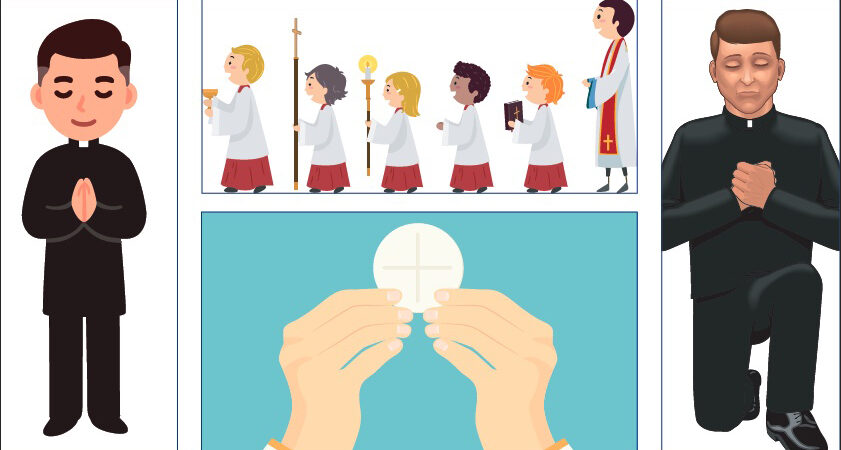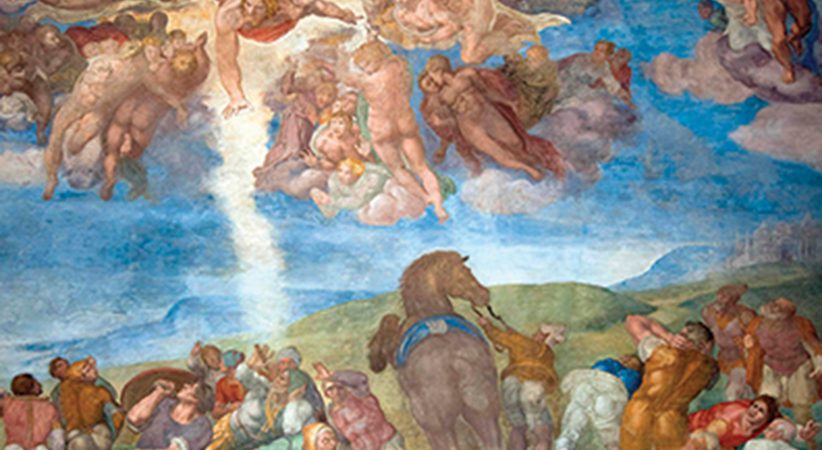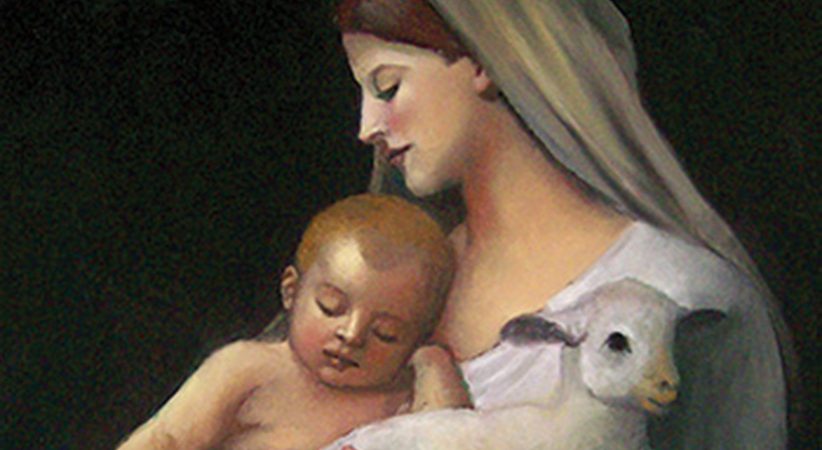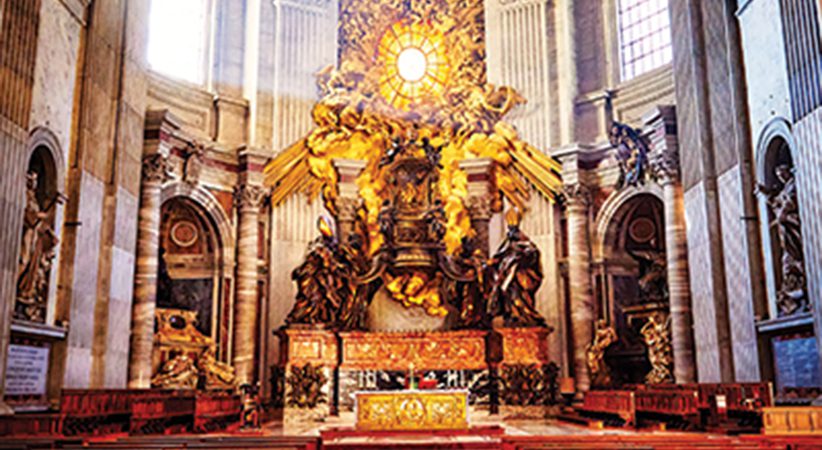The Beauty and Significance of Reverence in the Liturgy
The priest draws out the spiritual richness and theological depth of the Mass
Father Paul Turner Comments Off on The Beauty and Significance of Reverence in the Liturgy
“Reverence” is an elusive word that nonetheless governs some critical judgments on the celebration of the Mass. It is subjective. To some people, reverence means silence; to others, certain inspirational visual stimuli. To some, it means faithfulness to rubrics; to others, an increased use of Latin. Some Catholics become “judgy” of others when it comes to reverence.
Pope Benedict XVI helpfully articulated one view of reverence in his letter to bishops on the occasion of the publication of his apostolic letter given motu proprio, Summorum Pontificum. He wrote: “The most sure guarantee that the Missal of Paul VI can unite parish communities and be loved by them consists in its being celebrated with great reverence in harmony with the liturgical directives. This will bring out the spiritual richness and the theological depth of this missal.”
Indeed, reverence is neither a new concept nor a lost one. The 1970 missal repeatedly assumed its significance in the celebration of the Mass.
Communion
Reverence first appears in the General Instruction of the Roman Missal at its introduction. The GIRM upholds the doctrine of “the real presence of the Lord under the Eucharistic species,” and it says that the Mass expresses this belief “with a sense and a demonstration of the greatest reverence and adoration” (No. 3). The greatest number of references to reverence throughout the GIRM pertains to holy Communion because of the Catholic belief that Christ is truly present in this sacrament.
Before Communion, even the breaking of bread is to be carried out “with proper reverence” (No. 83). When the priest receives Communion, he “reverently” consumes the body of Christ and “reverently” partakes of the blood of Christ (cf. No. 158). The GIRM does not explain further what this means, so some priests bow to receive or pause afterward, governing the placement of their eyes and hands. Most important is that the priest approaches his Communion with internal reverence for the Sacrament.
When the faithful receive Communion in the United States, each is to bow “his or her head before the Sacrament as a gesture of reverence” just before receiving the body of Christ and again just before receiving the Precious Blood on those occasions when Communion is received under both kinds (cf. No. 160). A specific external sign represents internal faith.
The rubrics for Communion have long called for the people to make a gesture of reverence as determined by the conference of bishops. Only recently has the United States Conference of Catholic Bishops specified that this sign of reverence is to be a bow of the head. The gesture is simple enough to be executed by each communicant as an expression of individual faith in God and of shared belief with other communicants.
In practice, though, the gesture varies considerably. Some make a profound bow as they see other ministers do at different times of the Mass, such as when approaching the altar. Other communicants make a Sign of the Cross. Some genuflect. Some do a combination of these gestures. Many add more gestures after receiving Communion. Some do nothing. Renewed catechesis could bring more uniformity to the people’s gesture and call them to the internal reverence demanded at the moment of receiving Communion. To be avoided is carelessly taking the host while focusing distractedly elsewhere, such as on another person in line — or a message online.
If a host or a particle should fall, the minister is to pick it up “reverently” (No. 280). This is the only answer the GIRM gives to one of the most frequent questions asked by Communion ministers: “What do I do if a host falls?” Presumably, the communicant or the minister will consume it, or the minister will later dissolve it completely in water and pour it into the sacrarium. But the GIRM’s only expressed concern is that the minister picks it up reverently.
In recent decades, the Catholic Church broadened its permissions for Communion under both kinds, a practice that it judged “more readily conducive to reverence for the Sacraments and the good of the recipients” (No. 282). Far from weakening the honor due to the Eucharist, Communion from the chalice extends it.
As Communion draws to a close, the priest and deacon may consume what remains of the blood of Christ at the altar, a task that they are to perform “reverently” (Nos. 182, 247). This probably means in an intentional, solemn way, avoiding any hasty drinking as of some common beverage.
All of this reverence aims toward the consuming of communion with proper respect for the Sacrament. The Norms for the Distribution and Reception of Holy Communion Under Both Kinds in the Dioceses of the United States of America make over a dozen references to reverence in a scant 57 paragraphs. The proper reception of holy Communion demands a belief and reverence for the body and blood of Christ.
The Altar
By extension, the altar is an object of reverence. At the beginning of the Mass, the priest, deacon and ministers all bow to the altar as a first sign of reverence. As a second sign, the priest and deacon kiss the altar (cf. No. 49). If appropriate, a third sign is made: the priest incenses the cross and the altar (Nos. 49, 276). At the end of the Mass, the priest and deacon kiss the altar again, and then join the other ministers in a profound bow toward the altar (cf. No. 90). These reverences derive from the sacredness of the altar, made evident on the day that it was dedicated. It is a symbol of Christ, whom the fifth preface of Easter time calls the priest, the altar and the Lamb of sacrifice. Some people think that the kiss that opens and closes the Mass is directed toward relics embedded in the altar. The Ceremonial of Bishops explains, “In places where altars are customarily dedicated to God in honor of the saints, the practice may be continued, but it should be made clear to the people that the altar is dedicated to God alone” (No. 921).
In parishes where the tabernacle stands in the sanctuary, the ministers first genuflect to the tabernacle (cf. GIRM, No. 274). Many priests and deacons do not then make an additional bow to the altar before kissing it, but that seems to be the intent of GIRM, No. 49. The altar deserves that much reverence.
A cloth adorns the top of the altar “out of reverence for the celebration of the memorial of the Lord” (No. 304). Candles are placed on or around the altar “for reasons of reverence or the festive character of the celebration” (No. 307). Even the decoration of the altar expresses the community’s reverence for it.
The Word
The first part of the Mass, the Liturgy of the Word, deserves no less reverence. God speaks to the people, so everyone is to listen to the Word “reverently” (No. 29). This is a sacramental moment: The words are not the words of those who read. God is speaking.
“Great reverence” belongs to the Gospel (cf. No. 60). A deacon or priest proclaims it, a blessing or prayer prepares him for the task, an acclamation is sung, a procession forms, incense and candles may lead the way, and the faithful stand to listen. At the conclusion, the deacon or priest kisses the book. When a bishop presides, he may kiss it and bless the people with it (cf. Ceremonial of Bishops, No. 14; GIRM, No. 175).
In the entrance procession, the deacon or reader who carries the Book of the Gospels approaches the sanctuary, “omits the sign of reverence,” and places the book directly on top of the altar (cf. GIRM, No. 173). The Book of Gospels is also a sign of Christ. It also is kissed. It also is incensed. The minister is holding the book slightly elevated (No. 120 and No. 172), itself a sign of reverence due. While holding the book with honor, the minister makes no bow to the altar. That would interrupt one reverence to perform another one of equal measure.
Intentionality
The GIRM promotes “sacred silence” at designated times (cf. No. 45). In a culture filled with music and noise, both natural and electronic, moments of silence are rare. They indeed have a sacred quality at worship. The ministers and the people perform many actions and speak or sing many words. But at certain times no words can express what the heart believes. All will express reverence by a generous attention to silences in the penitential act, the collect, after the readings, after the homily and after Communion.
Certain gestures also have a reverent intent. “A bow signifies reverence and honor” (275). The GIRM distinguishes between bows of the head and those of the body. They all are simple gestures that show outwardly the inward attention to reverence.
A genuflection, by contrast, “signifies adoration, and therefore it is reserved for the Most Blessed Sacrament” (No. 274). A genuflection is made to the tabernacle upon entering and leaving the church, though not during the Mass. At Mass, the priest’s genuflections are directly to the newly consecrated elements during the Eucharistic prayer and before he receives Communion.
Not all Catholics understand this purpose of the genuflection. When the tabernacle is not in the sanctuary, many Catholics still mistakenly genuflect, apparently toward the altar or cross. Some oddly genuflect after receiving Communion as if something else is more important than the Communion they have just received. Catholics surely intend to make proper reverences, but sometimes their good intentions go amiss. With greater intentionality — bows to the altar during Mass and genuflections toward the tabernacle outside of Mass — people will bring greater outward expression to their strong internal faith.
Processions are to be done “with decorum” (No. 44). Whether at the entrance, the Gospel, the bringing of the gifts or the approach to Communion, these processions have a sacred purpose, not just a practical one. People can express their decorum by walking slowly, carrying objects respectfully and singing purposefully. Such intentionality displays reverence.
Those with speaking parts are to use their voice skillfully, as well. “The voice should correspond to the genre of the text itself” (No. 38). A prayer should sound different from a reading, an acclamation from an explanatory comment. Some forms of celebration are more solemn than others. Ministers intentionally use their voices to color the more reverent parts of the Mass.
Participation
The priest is responsible for fostering the full, conscious, active participation of the people. “Harmonious ordering and carrying out of the rites will greatly help in disposing the faithful for participation in the Eucharist” (No. 352). Furthermore, the priest “associates the people with himself in the offering of sacrifice,” and “by his bearing and by the way he pronounces the divine words he must convey to the faithful the living presence of Christ” (No. 93). Especially in the Eucharistic prayer the priest “associates the people with himself in the Prayer that he addresses in the name of the entire community to God” (No. 78). The priest’s reverence invites the people’s reverence.
Full, conscious active participation is the ultimate reverence that people show God during the celebration of the Mass. They participate through their postures and gestures, their silence and their song. When they do this intentionally, they assign reverence where it is due.
The priest leads the way. When he exercises “great reverence in harmony with the liturgical directives,” as Pope Benedict called it, he will draw out the spiritual richness and theological depth of the Mass.
By its nature, reverence is something internal that the voice and body may then express. Sometimes the internal reverence is real and deep, even though the external body looks neutral. Catholics need to be cautious about accusing someone of irreverence. As Samuel discovered when seeking out a new king of Israel, God reads the heart better than humans do (cf. 1 Sm 16:7). Catholics will find their strongest entrance into the beauty and significance of the Mass not through judging others but by contributing to reverence for the Word of God and the Eucharist they share.
FATHER PAUL TURNER is pastor of the Cathedral of the Immaculate Conception in Kansas City, Missouri, and director of the diocesan Office of Divine Worship. He serves as a Vatican consulter of the Dicastery for Divine Worship and the Discipline of the Sacraments. He is the author of “Ars Celebrandi” (Liturgical Press, 2021) and answers liturgical questions daily on his blog.





